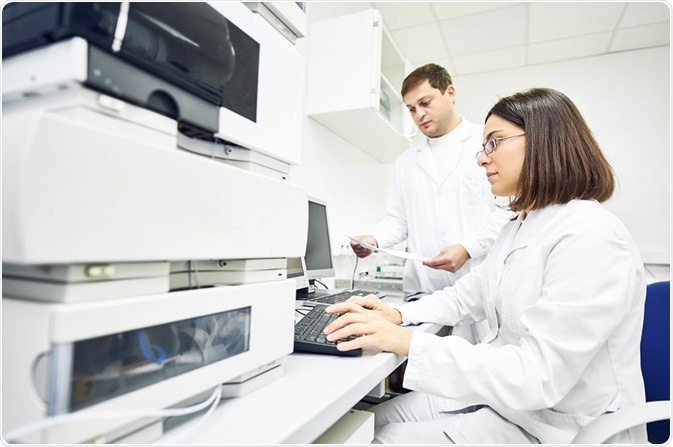Countercurrent chromatography (CCC) can be defined as "a technique of chromatographic separation based on the partition of solutes between two different liquid phases that does not get mixed together. The two phases are mobile phase and stationary phase (the support-free liquid)".

Researchers analyzing liquid chromotography data Credit: Dimitry Kalinovsky/ Shutterstock.com
This type of chromatography is otherwise known as “liquid-liquid chromatography” (LLC) and it uses special columns as both the phases are liquids and no solid matrix is used to retain the stationary phase.
These liquid phases use a thin tube to interact with each other under a field created by gravitational or centrifugal force with which stationary phase is held while the mobile phase is made to enter into it. The stability of the stationary phase happens only till the existence of the centrifugal field.
Principle and process of CCC
Countercurrent chromatography works based on the principle of partitioning of liquids in which the immiscible liquids are combined together and then separated several times. The isolation of each individual solute is done on the basis of the “partition coefficient” of that particular compound present in the solvent phase versus the diluents phase.
The partition coefficient “K” is obtained by taking the ratio of the distribution of the solute between the two mutually equilibrated solvent phases.
- Partition coefficient, K = The amount of solute in the stationary phase/The amount of solute in mobile phase
In this technology, the stationary phase, which is let into a column that spins at a reasonable rotational speed, is held by the generated centrifugal force. The movable phase that contains the solutes that should be separated is then fed into the column and is then pushed to the stationary phase.
Thus, both the phases get mixed. The interchange of molecules happens between the phases during this time and the solutes get separated based on the specific partition coefficient of each individual solute.
The phase that is mobile gets decanted at every cell outlets leading it to the subsequent cell. The remains of both the phases after elution that contain the individual purified solutes are then gathered over a period that ranges from a few minutes to hours.
History and advancement of CCC
The idea of the first Countercurrent Chromatography Machine was proposed by Craig and Post in the late 1940s. It consisted of a little more than a series of interconnected glass separating funnels held with 1g (gravity of earth) gravitational force.
This force was insufficient for stabilizing the stationary phase and could only use the denser phase as stationary. Even though it took days to complete the experiment with this machine, it had the capability to resolve highly complex mixtures. As the technique is gentle and gave high resolution, it was used in the purification of high-value products like Chinese medicines and other natural products.
The Droplet Countercurrent Chromatography (DCCC) is another technique developed by Ito in 1970. This technique also used 1g gravitational force to stabilize the stationary phase, whereas the mobile phase was pumped through the column.
The only advancement of this method from the previous one was that it allowed using any of the two phases as the stationary phase. However, the stabilization of the stationary phase remained poor even at low flow rates and it took days to complete the experiment. Poor phase-mixing was another disadvantage of this method.
The possibility of using centrifugal force for stabilizing stationary phase was experimented by Ito in the 1970s. He and his team developed a hydrodynamic planetary coil centrifuge made with Teflon or steel tubes wound helically in layers on a revolving bobbin. This technique was named as High-Speed Countercurrent Chromatography or HSCCC, as the experimental duration was only 3 to 4 hours.
Based on the principle of DCCC, Sanki (an instrument engineering company) developed Centrifugal Partition Chromatography (CPC) in the 1980s. CPC is a hydrostatic technique that contains a series of interconnected separation cells connected by capillaries in a radial arrangement placed around a disc. It rotates in single plane producing around 80g of centrifugal force.
The invention of High-Performance Countercurrent Chromatography (HPCCC) was done in the early 2000s. This technology runs with a centrifugal force of 240g and uses higher flow rates to produce the result in approximately 10 minutes. As the force is higher, the stationary phase stability is also higher here.
Cessation
There are many advantages for a chromatography technique that uses a liquid as the stationary phase. Some of them are:
- high loading capacity
- a simple retention mechanism
- use of either of the phases as mobile phase
- lack of pH-related problems
- low biological solute denaturation
- lack of irreversible solute adsorption.
All these benefits make it more preferable than other chromatographic techniques.
CCC, especially high-performance countercurrent chromatography, due to its high resolution and shorter experimental time is a widely accepted chromatographic technique in present times. Medical, natural, and traditional products can be easily purified in an efficient way and in a short time span using this technology.
Further Reading
Last Updated: Jul 19, 2023